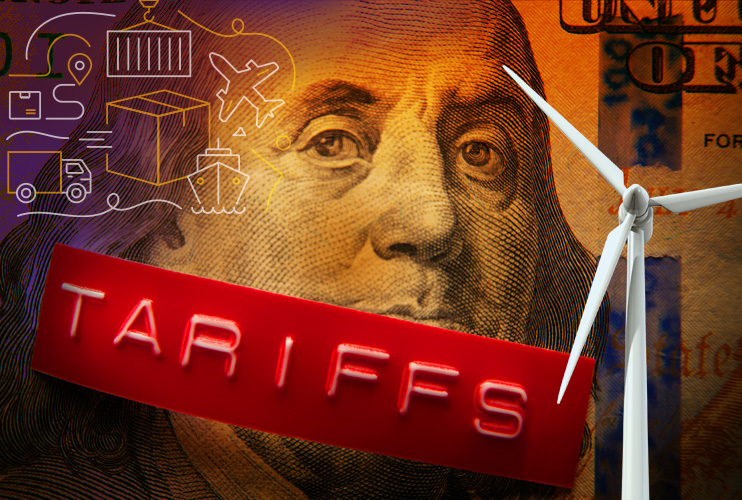Trade Wars and the Wind Industry: Why It Matters
Right now, wind developers and manufacturers are bracing for exactly that.
As trade tensions escalate between the U.S., Canada, China, and the EU, tariffs on critical wind components could drive up costs, delay projects, and slow the industry’s hard-earned momentum. The question at hand isn’t if tariffs will impact wind energy, but how much—and how quickly companies can adapt.
The Immediate Cost of Trade Tariffs
Turbine Prices Are Going Up
Modern wind turbines depend on materials that are prime targets for tariffs—steel, aluminum, and rare earth metals.
If trade restrictions hit key suppliers, the cost implications are immediate:
- Steel & Aluminum Tariffs: Wind towers and nacelles require high-strength steel and aluminum. Let’s imagine a 10-25% tariff on these materials that sticks: This could tack on millions to project budgets.
- Blades & Drivetrains: Many of these components come from China, Canada, and Germany. If tariffs raise their costs by 10%, say, overall project expenses could climb by 5-7%.
- Rare Earth Metals: Wind turbines use high-efficiency magnets, nearly all of which depend on rare earth elements sourced from China. Any disruption here could spike costs and limit supply.
Project Development Gets Harder
Wind farms already require substantial capital investment. A 5-10% increase in turbine costs forces developers to rethink financing, delaying projects or pushing power purchase agreement (PPA) prices higher.
That makes wind energy less competitive—especially in offshore projects, where costs are already two to three times higher than onshore wind.
Supply Chain Disruptions: Where Wind Energy is Most Vulnerable
Component Bottlenecks & Manufacturing Delays
Tariffs raise prices, and they tend to disrupt supply chains. Nearly 40% of wind turbine components used in U.S. projects are imported. If tariffs hit key supplier nations, expect significant delays in blade and turbine shipments, especially in the short term. With so many core components coming from overseas, trade restrictions could push project timelines back by months.
Look to grid connection equipment for similar delays. Transformers, inverters, and other power electronics critical to integrating wind farms into the grid are often sourced internationally. Tariffs could further slow already-complicated grid interconnection processes.
The U.S. has ramped up its turbine manufacturing, but key components—especially rare earth magnets—are still largely dependent on foreign suppliers.
Retaliation & The Global Renewable Market
If the U.S. imposes tariffs on imported wind components, other countries will respond. The likely outcomes:
- Tariffs on U.S. Wind Exports: China and the EU could slap duties on U.S.-made wind tech, making American firms less competitive abroad.
- Slower Foreign Investment: Trade disputes create uncertainty. If investors see the U.S. wind sector as unpredictable, they may shift their capital elsewhere.
The Rare Earth Metals Factor
China controls over 70% of global rare earth production, and wind turbines need these materials for their high-efficiency generators. If trade tensions escalate, China could restrict exports, creating a global supply crisis.
This isn’t just a hypothetical risk. China has already hinted at using rare earths as a geopolitical bargaining chip. If that happens, turbine manufacturers could be scrambling for viable alternatives. Project costs would soar.
How Wind Energy Can Adapt
Diversifying Supply Chains & Strengthening Domestic Production
Wind energy companies are already looking for ways to mitigate trade risks. Key strategies include:
- Expanding U.S. Manufacturing: More domestic production of turbine components could reduce reliance on tariffed imports.
- Sourcing from Non-Tariffed Regions: Companies may shift procurement to countries with favorable trade agreements.
- Stockpiling Critical Components: Some developers are pre-purchasing turbines, blades, and rare earth magnets before tariffs fully take effect.
Policy & Advocacy Moves
- Industry Pushback on Tariffs: Groups like American Clean Power (ACP) are actively lobbying to exempt wind energy components from trade disputes.
- Leveraging Tax Incentives: The Inflation Reduction Act (IRA) and other policies provide tax credits that can help offset tariff-related costs.
The Road Ahead: Preparing for an Uncertain Trade Landscape
Trade policy is unpredictable. But for wind energy, waiting to see what happens isn’t an option. Rising material costs, supply chain volatility, and retaliatory tariffs could reshape the economics of wind power. The companies that adapt—by diversifying suppliers, investing in domestic manufacturing, and staying ahead of trade policy changes—will be the ones that thrive.
Wind energy has spent years driving down costs and scaling up capacity. Tariffs threaten to slow that progress. But the right strategic moves now will keep the momentum going—ensuring wind remains a cornerstone of the global energy transition, no matter how the trade wars unfold.


